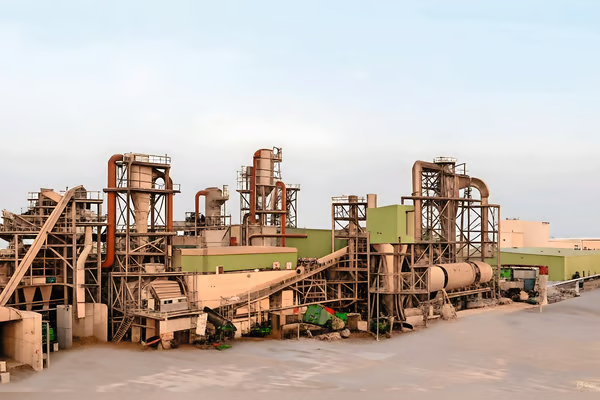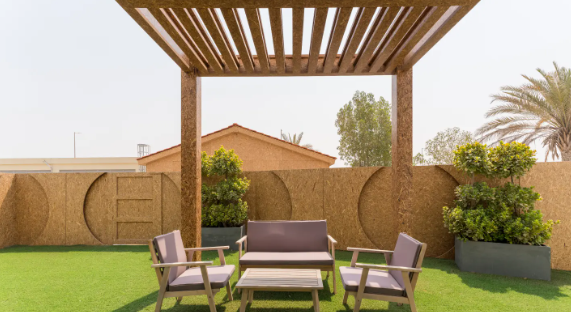Palm grove sustainability is at the heart of an innovative solution called DesertBoard, a game-changer in eco-friendly materials born in the Gulf region. Using the abundant palm fronds from the region’s iconic date palm groves, DesertBoard transforms agricultural waste into sustainable building materials. This initiative not only tackles environmental challenges but also celebrates the cultural and economic significance of palm groves in the Gulf. In this article, we’ll explore how DesertBoard is revolutionizing sustainability, its benefits, and why it matters for the future.
The Origins of DesertBoard
The Gulf region is home to millions of date palm trees, a symbol of life and prosperity in arid landscapes. These trees produce an abundance of fronds, which are often discarded or burned, contributing to waste and pollution. DesertBoard saw an opportunity to turn this waste into a resource. By collecting and processing palm fronds, the initiative creates a durable, eco-friendly material that can be used for construction, furniture, and more.
The idea was born from a desire to address two pressing issues: environmental waste and the need for sustainable building materials. Traditional construction materials like concrete and steel have a high carbon footprint. DesertBoard offers a greener alternative, reducing reliance on non-renewable resources while making use of a readily available local resource.

Why Palm Groves Matter
Palm groves are more than just agricultural hubs; they’re cultural landmarks in the Gulf. For centuries, date palms have provided food, shade, and materials for local communities. DesertBoard builds on this legacy by repurposing palm fronds, ensuring that these groves continue to contribute to the region’s economy and environment in modern ways.
- Cultural significance: Date palms are deeply rooted in Gulf traditions, symbolizing resilience and abundance.
- Economic potential: Utilizing palm waste creates new revenue streams for farmers.
- Environmental impact: Repurposing fronds reduces waste and lowers carbon emissions.
How DesertBoard Works
The process behind DesertBoard is both simple and innovative. Palm fronds are collected from local groves, cleaned, and processed into fibers. These fibers are then compressed and treated to create strong, lightweight boards. The result is a versatile material that rivals traditional wood or particleboard in strength but with a much lower environmental impact.
The Production Process
The creation of DesertBoard involves several key steps:
- Collection: Palm fronds are gathered from farms, preventing them from being burned or discarded.
- Processing: Fronds are shredded into fibers and cleaned to remove impurities.
- Binding: The fibers are mixed with eco-friendly resins and compressed into boards.
- Finishing: The boards are cut and treated for various applications, from construction to furniture.
This process is designed to be energy-efficient, using minimal water and avoiding harmful chemicals. The result is a product that’s not only sustainable but also cost-effective.
Benefits of DesertBoard

DesertBoard offers a range of benefits that make it a compelling choice for builders, designers, and environmentally conscious consumers. Its advantages extend beyond sustainability, impacting the economy and local communities.
Environmental Advantages
Palm grove sustainability is central to DesertBoard’s mission. By using agricultural waste, the initiative reduces landfill contributions and greenhouse gas emissions. Unlike traditional materials, DesertBoard requires no deforestation, preserving natural ecosystems. Additionally, the production process is designed to minimize energy use, making it a low-carbon alternative.
- Reduces waste: Keeps palm fronds out of landfills and incinerators.
- Lowers emissions: Produces less CO2 compared to concrete or steel.
- Preserves forests: Eliminates the need for logging hardwood trees.
Economic and Social Impact
DesertBoard creates opportunities for Gulf communities. Farmers benefit from an additional income source by selling their palm fronds, which would otherwise be discarded. The initiative also generates jobs in processing and manufacturing, boosting local economies. By promoting sustainable practices, DesertBoard helps position the Gulf as a leader in green innovation.
Versatility and Durability
DesertBoard is not just eco-friendly; it’s practical. The material is strong, lightweight, and resistant to moisture and pests, making it ideal for the Gulf’s harsh climate. It can be used for:
- Construction: Wall panels, roofing, and insulation.
- Furniture: Tables, chairs, and cabinets.
- Packaging: Sustainable alternatives to plastic or cardboard.
Challenges and Solutions
Like any innovation, DesertBoard faces challenges. Scaling production to meet global demand requires investment in infrastructure and technology. Additionally, raising awareness about the benefits of palm grove sustainability is crucial to gaining market acceptance. However, DesertBoard’s creators are tackling these hurdles head-on.
Scaling Production
To expand operations, DesertBoard is partnering with local governments and private investors to build more processing facilities. These partnerships aim to streamline collection and production while maintaining eco-friendly standards.
Educating the Market
Many consumers and businesses are unaware of palm-based materials. DesertBoard is addressing this through marketing campaigns and collaborations with architects and designers to showcase the material’s potential. Demonstration projects, such as eco-friendly homes built entirely from DesertBoard, are helping to build trust and interest.
The Future of Palm Grove Sustainability
The success of DesertBoard could pave the way for similar initiatives worldwide. Other regions with abundant agricultural waste, such as coconut or banana plantations, could adopt similar models. By promoting palm grove sustainability, DesertBoard is setting a precedent for how local resources can drive global change.
Global Potential
The concept behind DesertBoard is adaptable. Countries with large agricultural sectors could repurpose their waste into sustainable materials, reducing reliance on non-renewable resources. This could lead to a global network of eco-friendly material production, inspired by the Gulf’s palm groves.
Technological Advancements
Ongoing research is improving DesertBoard’s production process. Innovations in binding agents and processing techniques are making the material even stronger and more versatile. These advancements could lower costs and expand applications, making DesertBoard a mainstream choice.
Why DesertBoard Matters

DesertBoard is more than a product; it’s a movement. By harnessing the power of palm grove sustainability, it addresses pressing environmental challenges while honoring the Gulf’s cultural heritage. It shows that innovation doesn’t have to come at the expense of the planet. Instead, it can create a win-win scenario for communities, economies, and the environment.
A Call to Action
For consumers, choosing DesertBoard means supporting a greener future. For businesses, it’s an opportunity to lead in sustainability and meet the growing demand for eco-friendly products. Governments can play a role by incentivizing the use of sustainable materials through policies and subsidies.
Conclusion
DesertBoard is a shining example of how palm grove sustainability can transform waste into opportunity. By repurposing palm fronds, this initiative is reducing environmental impact, creating jobs, and preserving cultural heritage in the Gulf. As the world grapples with climate change and resource scarcity, solutions like DesertBoard offer hope. They remind us that sustainability is not just about sacrifice—it’s about creativity, community, and a commitment to a better future.
Read More: UAE to Salalah Travel: Your Ultimate Guide to an Unforgettable Trip













